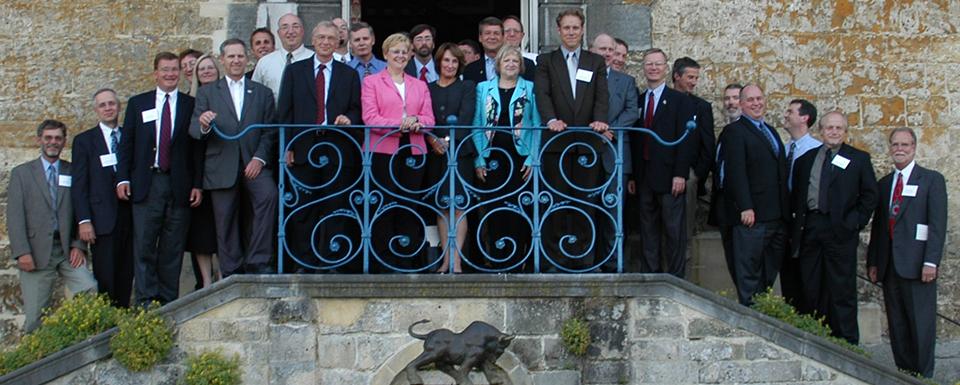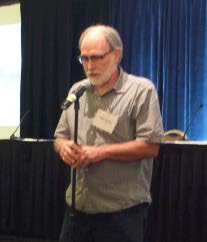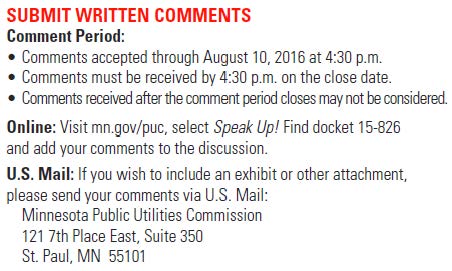Speak Up at Xcel Energy Rate Case Public Hearing
July 24th, 2016
Wednesday, at 7 p.m. at SE Tech College in Red Wing, there’s a public hearing about the Xcel Energy rate case (PUC Docket 15-826 — to look at all the filings GO HERE TO PUC SEARCH PAGE and search for docket 15-826).
Here’s my LTE in the Red Wing Republican bEagle:
Letter: Speak up at Xcel rate case hearing
We’re conserving – why should we pay more? Why are residential rates higher than large energy users?
I pushed for a hearing in Red Wing at the prehearing conference, and it’s next Wednesday: Xcel Rate Case Public Hearing, 7 p.m., Minnesota State College Southeast.
Carol A. Overland
Red Wing
Videos of Ken & Krie
July 23rd, 2016
Found some videos hiding of my dear departed Kenya and Krie, and I’ve posted here to archive:
MOV00315 – Chasing Wubbas at Frontenac Beach
MOV00314 – Krie heads to Wisconsin
MOV00312 – More Fetching Wubbas
MOV00166 – At Delaware City Park
MOV00165 – At Delaware City Park
MOV00164 – At Delaware City Park
MOV00163 – At Delaware City Park
DOE “Consent-Based” Nuclear Waste Mtg.
July 22nd, 2016
Well, that was interesting… and it took all evening!
First a sidebar, but an important one. The Agenda CBS Public Meeting-Minneapolis caught my attention, seeing PUC Commissioner John Tuma named front and center. The PUC’s page on Commissioner ex parte, conflict, and basic decorum has disappeared — I called the PUC about Commissioner Tuma’s appearance (fair warning, prior to event), and noted that the page had disappeared. Here are the rules (the page was what stressed the importance of avoiding even the appearance of impropriety:
7845.0400 CONFLICT OF INTEREST; IMPROPRIETY.
Subpart 1. General behavior.
A commissioner or employee shall respect and comply with the law and shall behave in a manner that promotes public confidence in the integrity and impartiality of the commission’s decision making process.
Subp. 2. Actions prohibited.
Commissioners and employees shall avoid any action that might result in or create a conflict of interest or the appearance of impropriety, including:
A. using public office for private gain;
B. giving preferential treatment to an interested person or entity;
C. impeding the efficiency or economy of commission decision making;
D. losing independence or impartiality of action;
E. making a commission decision outside official channels; and
F. affecting adversely the confidence of the public in the integrity of the commission.
7845.0700 PROHIBITED ACTIVITIES.
Subp. 4. Outside employment.
A commissioner or employee shall not negotiate for or accept outside employment or other involvement in a business or activity that will impair the person’s independence of judgment in the exercise of official duties.
I registered this in a Comment section, provided copies of the rules, and expected something similar to Commissioner Koppendrayer’s response in a similar situation years ago (see below). Commissioner Tuma is new, and being there was not the worst of possible activities, other past and present Commissioners have done much worse, but it’s not OK. His presence on the panel, on the stage, lends the impression of support of the DOE’s efforts, and nuclear waste, nuclear decommissioning funds, nuclear uprates and rehab, all are issues that have been and will be in front of the Commission in highly contested cases. It lends the appearance of losing independence, impartiality, and impairment of judgment in future exercise of official duties.
I’ve seen this a few times. One positive experience was at the Sawmill Inn when Commissioner Koppendrayer was named on a coal gasification love-fest panel when Excelsior’s Mesaba Project was before the PUC, and I’d called the Commission ahead of time and spoken to the then Asst. A.G. who said, not to worry, they knew ex parte and conflict of interest and rules of decorum. Yet at that meeting, which Koppendrayer DID attend despite advance warning, I jumped up and objected from the back of the room, noting the PUC’s focus on avoiding even the appearance of impropriety, and Koppendrayer said something like “Overland’s got a point, and I should leave” and he did! He earned quite a few “respect” points that day. IEDC gets carried away February 15, 2007.
On the other hand, I’m also remembering Commissioner Phyllis Reha’s coal gasification junket to Belgium via Great Plains Institute, a well-funded toady for coal gasification (and GPI was on panel last night, another cause for concern, how much were they paid!). How blatant can you get? MCGP Request for Recusal (Commission saw no problem!).
… and there’s her stumping for CapX 2020 transmission: PUC Commissioner Reha: Enhancing the Nation’s Electricity Delivery System. That was the basis of another Motion, but of course, Commissioner Reha and the Commission saw no problem with her actions! NoCapX Motion to Recuse Commissioner Reha & Exhibit A – Reha Power Point Presentation.
And then there’s Great Plains Institute’s involvement. After their intense and well funded toadying for coal gasification ($437,000 over 21 months), and transmission, and then Xcel Energy’s e21, Dog help us! Anything GPISD in involved with has got my attention, and not in a good way!
Last night’s agenda was packed, and we got a lot done. A guy name Scott Thomas (the NSP engineer perhaps?) was at my table and jumped up and objected when we had a bit of opposition theater, I jumped up to counter, DOH, every hear of freedom of speech. I mean really, it took all of 5 minutes, let people speak up!
Here’s my comment, in large part based on “consent” a la SNUY’s approach for sexual consent, substituting “nuclear” for sexual — if we’re going to get screwed, this is the best possible of consent definitions:
Here’s the DOE’s Consent-Based Siting page. Notice was in the Federal Register, who reads that? Invitation for Public Comment in the Federal Register. Comments are being taken through July 31 or email to them at consentbasedsiting@hq.doe.gov.
Here’s how they’re framing it, with questions to be answered:
- How can the Department ensure that the process for selecting a site is fair?
- What models and experience should the Department use in designing the process?
- Who should be involved in the process for selecting a site, and what is their role?
- What information and resources do you think would facilitate your participation?
- What else should be considered?
We broke into small groups and actually had a pretty good discussion. Peggy Rehder, Red Wing City Council, was also at “Table 2” and of course we’re disagreeing. She’s frustrated at having spent 6 years on this and getting nowhere, but in terms of nuclear waste, 6 years is but a second or two… I’ve got 22 years in, and some there had many more. A key point was that the DOE must restore trust if it wants to get anywhere, and how would that happen? Stopping production of more nuclear waste is a key step. Dream on… this process is a move to enable continued generation of nuclear waste, continued operation of nuclear plants, now being relicensed, uprated, nuclear waste expanded.
Prairie Island’s President Shelly Buck was on the panel, and that was good — PIIC is in such a mess, the plant and nuclear waste right next door, and they’ve been screwed over so many ways, so many times. Will they be regarded as a “stakeholder” this time around? They’ve intervened in so many nuclear matters, doing everything they can to protect the Community…
Parts of it were webcast. There will be a video of the evening’s festivities sometime, LINK HERE (when it’s posted, scroll down to “Minneapolis”) and there was a photographer snapping shots every few seconds (hmmmm, well, I guess that will be added to all our files!).
Karen Hadden, SEED Coalition (that SEED Coalition grew from Energy Foundation funding, same as MN’s defunct “SEED Coalition” which morphed into “RE-AMP” about 2005), was present, and vocal (YES!), regarding their concerns about nuclear waste siting in Texas and New Mexico, particularly about a recent application to NRC for a nuclear waste storage facility in western Texas, near the New Mexico border. See www.NoNuclearWasteAqui.org for more info.
Alan Muller, environmental consultant in Minnesota, and Exec. Dir. of Green Delaware, spoke of his having TWO Prairie Island reactors on the other side of town here in Red Wing, and the THREE Salem and Hope Creek reactors, visible from the office window in Port Penn, Delaware.
Here’s the Arizona meeting, CHECK OUT THE VIDEO HERE. Well worth the listen, the panel is much better qualified than the one in Minnesota (with the exception of Prairie Island’s Shelly Buck, and Canada’s Kathryn Shaver from their Adaptive Phases Management Engagement and Site Selection, Nuclear Waste Management Organization, listen up to them when Mpls. video is released).
Take some time and consider the DOE’s informational booklet. Put your thoughts together and send in comments: consentbasedsiting@hq.doe.gov.
I think it’s worth trotting out the EQB Citizens Advisory Task Force report on nuclear waste, from the Florence Township Nuclear Waste Daze:
Florence Twp Site – Citizens Advisory Task Force – Nuclear Dry Cask Storage
And also thing about the many casks on Prairie Island — those TN-40s and TN-29 have aluminum seals that need to be replaced EVERY 20 YEARS, and to my knowledge they’ve not been replaced, and there are casks that have been loaded and sitting there for more than 20 years. What’s up with that? What’s the plan? Back when they were permitting that, there was no plan. So…
Consider this 3 Stooges approach to cask unloading — don’t know of any other attempt to unload casks, maybe that’s one of the lessons learned here:
Here’s an INEL report on a TN24 leak:
And an NRC report on unloading:
NRC INFORMATION NOTICE 97-51: PROBLEMS EXPERIENCED WITH LOADING AND UNLOADING SPENT NUCLEAR FUEL STORAGE AND TRANSPORTATION CASKS
Here’s an EPRI report on (these technical reports are important!) Creep and Crud, which occurs with storage:
Here’s a report generated after the “ignition event” at Pt. Beach, where spent fuel was loaded in a cask, then set out of the pool, and let sit overnight, then they attempted to well it, well, welding cask full of bubbles of hydrogen from the interaction of zinc and the acidic solution the assemblies are sitting in, left overnight, BOOM!
Where are all the reports about the weld flaws on the VSC-24 casks? They’re in Pt. Beach, Palisades, and Arkansas One.
And here’s a report relevant to us here in Minnesota, given all our granite and our “2nd place” position in the federal site selection resulting in “choice” of Yucca Mountain:
Center of the American Experiment is off track
July 18th, 2016
Under a meme “Raise your voice… before they raise your rates” on a friend’s fb page, the Center of the American Experiment goes off the rails. They’re fixated on renewable energy as the driver of the Xcel Energy rate case and rate increase, but don’t want to bother with the facts. Well, it is the Center of the American Experiment, after all…
There’s no posting of the public hearing schedule, and no links to send comments, so what’s the point? Guess they just want to rant. I posted info on the schedule, and info about the transmission driver, and surprise, they deleted my comments!
Time to trot out this old favorite:
In Grist today: Transmission Lies
And here’s CAE‘s take:
Renewable Mandate Drives New Increase in Utility Bills
“AARP knows that when utility bills go up, it hurts Minnesota families, especially those on fixed incomes or struggling to make ends meet. That’s why we’re fighting make sure you only pay what’s fair and reasonable for reliable utility service.” (the quotes aren’t formatting correctly, hence “)
“We’re making improvements to our distribution and transmission systems for continued reliability, the ability to safely integrate new energy on our system and to continue to provide carbon-free nuclear energy. Those improvements require investments, so we’re also working with regulators to bring more predictability to your energy bills.” (the quotes aren’t formatting correctly, hence “)
Above is the public hearing schedule for the Rate Case, which apparently CAE does not want published. IF YOU GO TO THE HEARING AND OFFER ORAL COMMENTS, ASK TO BE PUT UNDER OATH (swear or affirm) TO GIVE YOUR TESTIMONY EXTRA OOOOOOMPH!
And to send in written comments, here’s from the PUC blessed Xcel Notice:
Xcel Rate Case Hearings on Tuesday & Wednesday
July 17th, 2016
There are a few more hearings for Xcel Energy’s rate case coming up:
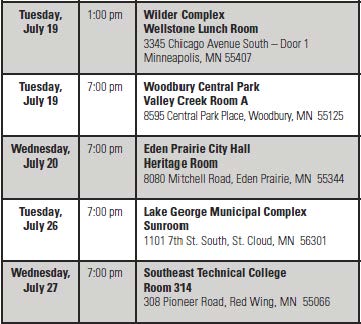
Who cares about this rate case? Center for American Experiment does, but it’s a pretty myopic view, claiming that “Renewable Mandate Drives New Increase in Utility Bills.” Wish they’d read the testimony. Anyway, you all should care because this is a transmission driven rate case (see 2A2_MYRP_Chuck Burdick Testimony p. 28-30; 2C2_Xmsn_Benson) Greasing the skids was a consensus agreement reached by Xcel Energy on many issues, including Xcel’s proposal for a “Multi-Year Rate” plan prior to legislation being introduced to give Xcel what it wanted:
Exhibit 1B – e21_Initiative_Phase_I_Report_2014 – Xcel Filing PUC Docket 14-1055
Note this snippet, where they’re whining that their grid is only 55% utilized:
(N) Identify and develop opportunities to reduce customer costs by improving overall grid efficiency. In Minnesota, the total electric system utilization is approximately 55 percent (average demand divided by peak demand), thus providing an opportunity to reduce system costs by better utilizing existing system assets (e.g., generation, wires, etc.). (e21_Initiative_Phase_I_Report, p. 11).
Well, DOH, we know that CapX 2020 wasn’t needed, we know the purpose was evident in the map starting at the Dakota coal fields, and putting it on our land wasn’t enough (for those who think it’s “for wind” no, it’s not, what a crock, you should have heard the testimony, seen the exhibits, the record demonstrates it isn’t, www.nocapx2020.info), now they want a whole new scheme for us to pay for their infrastructure to sell coal eastward?
 For some reason, this docket disappeared… wonder who all on this consensus e21_Initiative_Phase_I_Report made that happen!?!
For some reason, this docket disappeared… wonder who all on this consensus e21_Initiative_Phase_I_Report made that happen!?!
 Or maybe the e21 Project Team?
Or maybe the e21 Project Team?
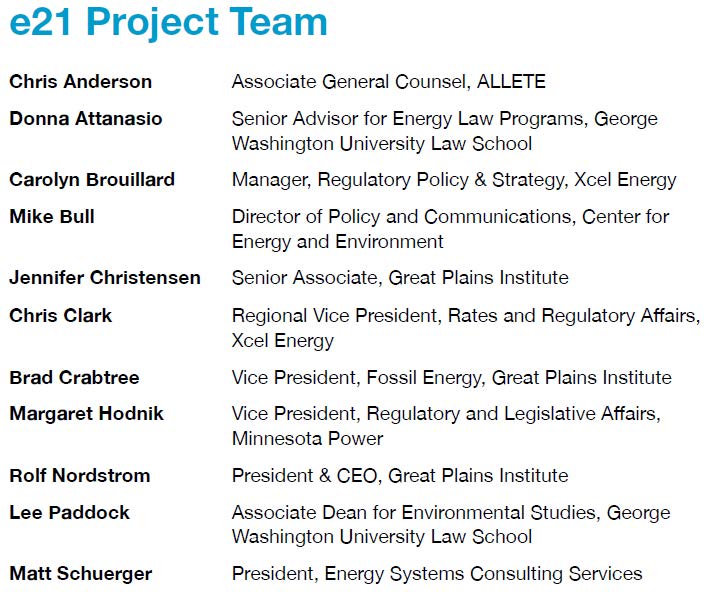 Does anyone else care that Matt Schuerger, most recent Dayton appointee to the Public Utilities Commission, was instrumental in working the e21 scam? Shouldn’t he have to recuse himself from any consideration of Xcel Energy’s e21 Initiative rate case?
Does anyone else care that Matt Schuerger, most recent Dayton appointee to the Public Utilities Commission, was instrumental in working the e21 scam? Shouldn’t he have to recuse himself from any consideration of Xcel Energy’s e21 Initiative rate case?
And look at Bill Grant’s role in e21. He’s now Deputy Commissioner at Commerce in charge of energy issues, and was for 20+ years head of Midwest Izaak Walton League (working over then employee Beth Solholt and IWLA employee, now PUC Commissioner, Nancy Lange). Given Nancy Lange’s role in e21, she should also recuse herself.
And then there’s Mikey Bull’s role, as he recounts, and look who all is involved:
The e21 Initiative started as little more than a glimmer in my eye a couple of years ago, when I was a Manager of Policy and Strategy for Xcel Energy. I’d just come back from a meeting at the Edison Electric Institute about the impact of various dynamics – low load growth, increasing infrastructure investments, deeper penetrations of distributed resources – on the current utility business model. In general, rates were going to rise under the current model far faster as a result of those forces, and utility revenues become more uncertain.
Those dynamics were later chronicled in the Disruptive Challenges report issued by the Edison Electric Institute in January 2013. I realized that it was important for Xcel to try and get out ahead of the curve.
So I reached out from Xcel to Rolf Nordstrom at the Great Plains Institute and Nancy Lange then at CEE (now a Minnesota PUC commissioner), to start putting the e21 project together. Rolf and I worked to put a strong core project team together – CEE, Great Plains, Xcel Energy, Minnesota Power, George Washington University Law School and consultant Matt Schuerger. We then compiled a terrific group of stakeholders who together represent much of what constitutes the public interest – low income customer advocates, small and large business representatives, utilities, environmental organization, cities and other public entities, and regulators. Beginning last February, this group of 25-30 stakeholders met monthly for day-long sessions that were wonderfully facilitated by Rolf and Jennifer Christenson, his colleague at GPI, toiling together deep in the weeds of utility regulation.
It was an honor to work with all of them, as we coalesced around the set of consensus recommendations detailed in the report.
Here’s the full recap:
The legislation, SF1735, well, check the links below, and you can see how that went down. I was there, seeing is believing. First it was introduced, but despite the full room of SILENT “usual suspects” who had acquiesced to e21, and only a couple of us objecting to the bill, Sen. John Marty pulled it from consideration, initially on the Senate Energy and Environment Committee same days as legislative extension of the Getty and Black Oak wind contracts (the project couldn’t do it before the PUC so they go to the legislature), stuck in a placeholder “e21 Lite” and then put it in later as part of the Energy Ominous Bill, SF 1431:
- the problems with SF 1735… March 18th, 2015
- Bill to extend Getty/Black Oak wind contracts? (e21 discussed at this Committee meeting) March 24th, 2015
- SF 1735 – SHAME on each Senator who voted for it (in the Energy Ominous Bill) May 5th, 2015
These issues were raised, e21 marches onward, and here we are, in a rate case.

![20160721_172836[1]](https://legalectric.org/f/2016/07/20160721_1728361.jpg)
